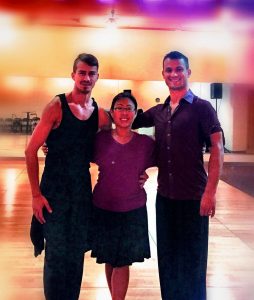After class, on your sweaty, post-adrenaline-high walk back to your car, you marvel at the dance community and how far you have come since that fateful day you happened upon that one workshop.
You’ve received your team shirt, your team nickname, and started eating instant ramen to afford the comp fees and costumes.
Somewhere in between 9PM and 2AM the night before that big show, it hits you; there is so much more to dance than just learning steps and formations.
Here are 5 valuable things you have learned from being a dancer.

1. When to step up – and when to step back
You aren’t the only person on your dance team. Having to share the spotlight means you begin to build awareness of the role that you play amongst the 40+ people you dance with.
Being on a dance team encourages us to challenge ourselves with introspection, and to be comfortable with switching between being heard/seen, and stepping back to let others shine.
On any team, there are those who may be more gregarious and outspoken as well as those who are shier and more reserved.
We also know that a team full of outspoken dancers tends to bring about inefficiency, so it becomes an important skill to build to learn when to speak up (stepping up), and when to listen (stepping back).
This goes for class-takers as well: switching lines while taking class, letting other people stand in the front if you’ve learned the choreography before, and pushing yourself to stand in front for groups (if you know you tend to shy away from center stage) – these are all good practices in learning to step up/step back.
2. Grit
Between taking classes and workshops, casting for pieces, and getting feedback from your choreographer/director/coordinator comes with the territory of dejection.
As much as we still lament about these things at post-practice outings with our teammates, we learn to develop thicker skin.
Grit is exactly that – building strength of character and resolve.
Learning to take these feelings of dejection in stride helps us build such resilience; being able to receive feedback with open ears and an open heart is crucial to success.
Here’s an amazing TED talk about how grit is the key to success:
3. A sense of oneness with those around you/a sense of community
It’s all about that home away from home – on a team, we learn to develop a strong sense of family; we look for one another, spend copious amounts of time with one another, and and grow to become protective over one another. In class, there is a sense of looking out for one another.
Asking the person next to us what that last move was, being respectful to other class-takers, sitting down if we’re in the front few rows while the choreographer demonstrates his/her musicality are all evidences of a sense of community within a class setting.
We learn to build rapport with others and the importance of gelling well with others.
4. An eye for detail
We practice the art of mimicry of movement. We undergo thorough team cleaning. We look at class or performance footage with a sinking realization our arms didn’t extend like we thought they did, or our angles weren’t as crisp as we would’ve liked. Over time, we build a hyper-awareness of what the choreographer is doing compared to what our body is doing.
We develop a keen awareness of what pictures our body is hitting and whether they match that of the choreographer’s, and if we discern that there is something off, we learn to pinpoint what it is and fix it.
5. Mental stamina
You too, can eventually join other class enthusiasts and take 3-4 back-to-back classes without feeling like death.
Mental stamina is a natural byproduct of your craft – whether you’re a dancer on a team or a zealous class-taker, in between learning choreo and remembering changes to choreography and blocking, we build mental endurance.
And while taking back-to-back classes may at first be your Everest, with practice and repetition, you will find that retention gets easier with time.
The article was found at blog.steezy.co and it was originally published on September 8, 2014.
North Shore Dance Society